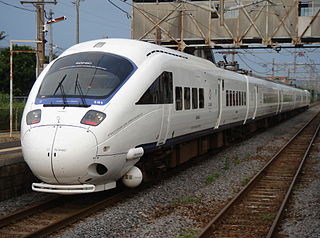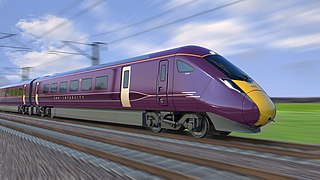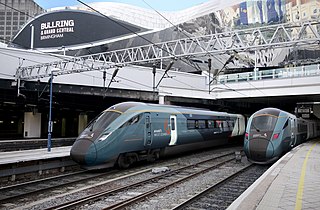
The InterCity 125 or High Speed Train (HST) is a diesel-powered high-speed passenger train built by British Rail Engineering Limited between 1975 and 1982. A total of 95 sets were produced, each comprising two Class 43 power cars, one at each end, and a rake of seven or eight Mark 3 coaches. The name is derived from its top operational speed of 125 mph (201 km/h). At times, the sets have been classified as British Rail Classes 253, 254 and 255.

Great Western Railway (GWR) is a British train operating company owned by FirstGroup that operates the Greater Western passenger railway franchise. It manages 197 stations and its trains call at over 270. GWR operates long-distance inter-city services along the Great Western Main Line to and from the West of England and South Wales, inter-city services from London to the West Country via the Reading–Taunton line, and the Night Riviera sleeper service between London and Penzance. It provides outer-suburban services in West London; commuter services from its London terminus at London Paddington to the Thames Valley region, including parts of Berkshire and Buckinghamshire, and Oxfordshire; and regional services throughout the West of England and South Wales to the South coast of England. Great Western Railway provides and maintains the Electrostar Class 387 fleet for Heathrow Express.

The InterCity 225 is an electric push-pull high speed train in the United Kingdom, comprising a Class 91 electric locomotive, nine Mark 4 coaches and a Driving Van Trailer (DVT). The Class 91 locomotives were built by British Rail Engineering Limited's Crewe Works as a spin-off from the Advanced Passenger Train project, which was abandoned during the 1980s, whilst the coaches and DVT were constructed by Metro-Cammell in Birmingham and Breda in Italy, again borrowing heavily from the Advanced Passenger Train. The trains were designed to operate at up to 140 mph (225 km/h) in regular service, but are limited to 125 mph (200 km/h) principally due to a lack of cab signalling and the limitations of the current overhead line equipment. They were introduced into service between 1989 and 1991 for intercity services on the East Coast Main Line (ECML) from London King's Cross to Leeds, York and Edinburgh.

The British Rail Class 91 is a high-speed electric locomotive, which produces power of 4,830 kW (6,480 hp); it was ordered as a component of the East Coast Main Line modernisation and electrification programme of the late 1980s. The Class 91s were given the auxiliary name of InterCity 225 to indicate their envisaged top speed of 225 km/h (140 mph); they were also referred to as Electras by British Rail during their development and throughout the electrification of the East Coast Main Line.

The British Rail Class 43 (HST) is the TOPS classification used for the InterCity 125 High Speed Train diesel-electric power cars, built by British Rail Engineering Limited from 1975 to 1982, and in service in the UK since 1976.

North Pole depot is a railway and maintenance depot built for Great Western Railway's AT300 units from the Hitachi A-train family. Located in the London Borough of Hammersmith and Fulham, the depot was partially redeveloped by Agility Trains from 2013 as a maintenance site when they were awarded the Intercity Express Programme.

Old Oak Common TMD was a traction maintenance depot located west of London Paddington, in Old Oak Common. The depot codes were OC for the diesel depot and OO for the carriage shed. In steam days the shed code was 81A.

The Intercity Express Programme (IEP) was an initiative of the Department for Transport (DfT) in the United Kingdom to procure new trains to replace the InterCity 125 and InterCity 225 fleets on the East Coast Main Line and Great Western Main Line. These new trains were designed and produced by Hitachi as part of their A-train family, classified as Class 800 electro-diesel units and Class 801 electric multiple units. Hitachi categorises the units as ta part of the AT300 family and has referred to them as the Hitachi Super Express Train.

Agility Trains is a consortium that presently comprised the Japanese rolling stock manufacturer Hitachi, multinational insurance and investment company Axa UK, and the infrastructure fund GLIL Infrastructure.

The Hitachi A-train is a family of rail rolling stock built and designed by Hitachi Rail using a common base and construction techniques. The stock is designed to facilitate a number of product life-cycle improvements including ease of manufacture, increased energy efficiency, and recyclability.

The British Rail Class 800, branded as the Intercity Express Train (IET) by Great Western Railway (GWR) and Azuma by London North Eastern Railway (LNER) is a type of bi-mode multiple unit train built by Hitachi Rail for GWR and LNER. The type uses electric motors powered from overhead electric wires for traction, but also has diesel generators to enable trains to operate on unelectrified track. It is a part of the Hitachi AT300 product family.

Doncaster Carr rail depot is a railway vehicle maintenance depot located alongside the East Coast Main Line in Doncaster, England. It is presently operated by Hitachi as part of their contract to maintain the AT300 units for London North Eastern Railway and TransPennine Express.

The British Rail Class 802 is a type of high-speed bi-mode multiple-unit passenger train designed and produced by the Japanese manufacturer Hitachi Rail. It has been operated by Great Western Railway, TransPennine Express, and Hull Trains; each of these train operating companies has given its own units a unique brand: Great Western Railway's units are branded Intercity Express Trains (IETs), TransPennine Express units are branded Nova 1s and Hull Trains' units are branded Paragons.

Hitachi Newton Aycliffe is a railway rolling stock assembly plant owned by Hitachi Rail Europe, situated in Newton Aycliffe, County Durham, in the North East of England.

London North Eastern Railway (LNER) is a British train operating company. It is owned by DfT OLR Holdings for the Department for Transport (DfT). The company's name echoes that of the London and North Eastern Railway, one of the Big Four companies which operated between 1923 and 1948.

East Midlands Railway is a British train operating company owned by Transport UK Group, and is the current operator of the East Midlands franchise.

The British Rail Class 810 Aurora is a type of bi-mode multiple unit being constructed by Hitachi Rail for East Midlands Railway. Based on the Hitachi AT300 design, 33 five-car units will replace Class 222 units on EMR's intercity routes.

The British Rail Class 803 AT300 is a type of electric multiple unit built by Japanese rolling stock manufacturer Hitachi Rail for open-access operator Lumo. Based on the Hitachi A-train design, a total of five units comprising five cars have been produced. The class is used to operate passenger services on the East Coast Main Line between London King's Cross and Edinburgh Waverley.

The British Rail Class 805 AT300 is a type of bi-mode multiple unit which is being built by Hitachi Rail for Avanti West Coast. Based on the Hitachi A-train design, 13 five-car units are being built to replace Class 221s on services between London Euston, Birmingham New Street and stations on the North Wales Coast lines. Their introduction is intended to allow the elimination of long-distance diesel working on electrified routes.

The British Rail Class 807 AT300 is a type of electric multiple unit being built by Hitachi Rail for train operator Avanti West Coast. Based on the Hitachi A-train design, a total of 10 seven-car units will be produced.
























